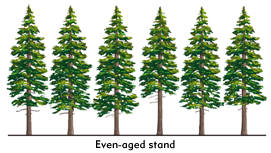Part 2 - Major parts of silvicultural systems
After completing this chapter you should be able to:
- describe the major types of silvicultural systems
- appreciate the subtle differences between a seed tree and shelterwood system
- recognize some outdated and confusing terminology
- understand how reserves play a role in silvicultural systems and impact on terminology.
Terms to remember
- clearcut
- patch cut
- seed tree
- shelterwood
- selection
- coppice
- reserves
- retention
- retention system
The general categories of silvicultural systems
To support your understanding of silvicultural systems, we will first provide an overview of the major categories of the systems. Once the subtle differences between the major categories are clear, we will delve further into the variations of these systems.
Note: The BC government record-keeping system separates the various silvicultural systems into major types which include patch cuts and clearcut with reserves. However, both patch cuts and clearcut with reserves are in fact variations of the clearcut system.
Even-aged systems
Clearcut system
In a clearcut system the stand overstorey is generally removed in one harvest. New even-aged stands are regenerated after harvest within the previously cleared block.
The clearcut system incorporates all of the advantages associated with managing an entire stand uniformly through time (see Appendix 2). Generally, this system is used to replace old stands with a new vigorous stand as quickly as possible. Sometimes, as in lodgepole pine, these old stands are starting to break up and are highly susceptible to damaging agents such as mountain pine beetle. In North America the public is pressuring forest managers to alter this approach to old stands. Old-growth forests are viewed by some as having special intrinsic values, in spite of deteriorating timber and ground forage cover values. Such a situation is unprecedented in forestry and provides us with our greatest challenge in developing silvicultural systems.
Numerous growth and yield models and tools are available to help managers design clearcut systems to produce certain volumes of specific timber products. Stand-tending operations, such as thinning, pruning, and fertilization, can easily be incorporated into the system to meet these specific objectives.
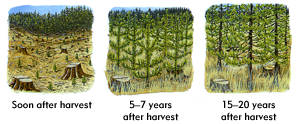
Quotes:
Clearcutting has the potential to create the greatest degree of ecological change in the harvested ecosystem. This change may be either desirable or undesirable, acceptable or unacceptable, according to the type of forest and the management objectives for the forest.
Hamish Kimmins (1992)
"Clearcutting" is really a word with many meanings as well as an ugly connotation; as a term of technical silviculture, it is an unhappy attempt at redefinition of a logging term and might better be replaced.
David Smith (1986)
Seed tree system
In a seed tree system the entire cutting unit is managed as it is with clearcut systems. However, for a designated time period, those trees selected for supplying seed are not harvested. Trees are generally left just to supply seed for the next crop; therefore, the best phenotypes should be selected to try to encourage desirable genetic traits.
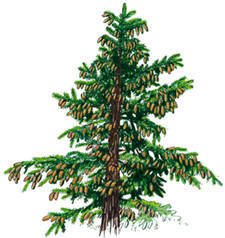
A classic seed tree system depends on natural regeneration, although the seed trees may not be relied upon entirely and some planting may occur under seed trees, often at reduced stocking levels. Usually, the seed trees are harvested in a "removal cut" once regeneration is established.
Seed tree with reserves
When a block is managed as a seed tree system, but selected trees are reserved from removal cutting to meet long-term objectives not related to regeneration, such a silvicultural system is called a seed tree with reserves. These reserve trees are usually left to satisfy non-timber resource objectives such as visual landscape management and special wildlife habitats.
What are reserves?
Reserves are individual trees or groups of trees retained during harvest, or other forest management operations, to provide non-timber values such as wildlife habitat, aesthetics, and biodiversity. Reserve trees are generally left for a rotation or more. However, the reserves left after the initial harvest can be replaced with new reserves from the regenerated stand, once the new stand provides the structural attributes associated with older forests such as large wildlife trees, coarse woody debris, and canopy gaps.
Can any silvicultural system be modified "with reserves"?
Reserves are most often associated with the silvicultural system clearcut with reserves. However, as you can see in the previous case study, reserves are required to be used with all silvicultural systems to ensure the protection of wildlife trees, an undisturbed forest floor, coarse woody debris, and other important stand-level attributes.
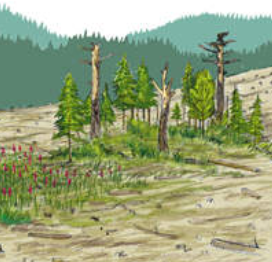
Drawing of harvest area with reserves.
Note: In British Columbia more than 90 wildlife species, or 16% of the province's vertebrates, depend to some extent on wildlife trees for reproduction, feeding or shelter. Key attributes of early winter range for mountain caribou include low evergreen shrubs, lichens available as litterfall and on windthrown trees, and a conifer canopy that intercepts snow.
Shelterwood system
In a shelterwood system the old stand is removed in a series of cuttings to promote the establishment of an essentially even-aged new stand under the shelter of the old one. Stand tending treatments are conducted to facilitate future harvesting in this manner.
The primary intent of this system is to protect and shelter the developing regeneration. Although shelterwood systems produce natural regeneration, some trees may be planted to diversify the species mix and bolster stocking. The central feature of shelterwoods is that the overstorey leave-trees are now left on-site to protect the regenerating understorey until the understorey no longer requires the protection. At some point the overstorey may start to actually inhibit proper development of the understorey trees through crown expansion and shading, although this will depend on the density of overstorey trees and the species being managed.
Criteria for leave-trees in seed tree and shelterwood systems
- larger, dominant trees
- windfirm trees
- desirable species
- desirable physical characteristics
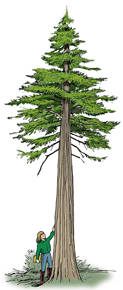
Harvesting entries in a typical shelterwood
Shelterwoods are implemented by using a series of harvesting entries, each with specific objectives and characteristics. To fully understand the shelterwood system, it is important to understand the nature and intent of these harvesting entries.
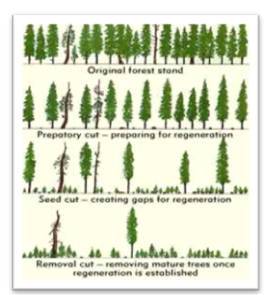
Above: Original forest stand; Preparatory cut - preparing for regeneration; Seed cut - creating gaps for regeneration; Removal cut - removing mature trees once regeneration is established.
- Preparatory cuts: One or several preparatory cuts may improve the vigour of prospective seed-bearing trees such that they can produce a healthy cone crop and be windfirm. Most preparatory cutting is concentrated in the lower canopy classes; in effect, this harvest is similar to a low commercial thinning. If leave-trees can respond and improve growth and vigour, this often overlooked treatment may contribute the most to a successful shelterwood system. As well, it can provide harvestable volume from stands previously considered too young for harvesting.
- Establishment cut, seeding cut, or regeneration cut: This cutting, which may be the first cutting in some stands, is intended to provide growing space for the regeneration to establish and to provide shelter for the young developing seedlings.
- Removal cut(s): Once regeneration is established, stocking is acceptable, and shelter is no longer required, the sheltering overstorey is usually removed. If left too long the sheltering overstorey may hinder the developing regeneration, through excessive competition for light, moisture and/or nutrients. For shade-tolerant species it may be desirable to remove the overstorey gradually with several removal cuttings over a period of time. Shelterwood systems tend to promote even-aged stands because the cutting and regeneration period is still concentrated near the end of one rotation and the beginning of the next.
- Salvage cut: This non-uniform commercial thinning removes windthrow, insect- or disease-killed timber, etc.
Should a shelterwood look different than a seed tree?
We often make the mistake of naming a silvicultural system based on its appearance after harvesting. While the names of the systems may encourage some focus on harvesting patterns (i.e., clearcut), the real difference between the systems is in the intent that each has for regeneration and stand development.
While it is tempting to set arbitrary densities that will differentiate between seed tree and shelterwood systems at the regeneration or seed cut phase, such categories may in fact lose sight of the intent of the systems. If the leave-trees are to be maintained just for their seed, the system should be called a seed tree system. If the intent is to also provide shelter, the system should be called a shelterwood. There is no magic number of trees left on a site that differentiates a shelterwood from a seed tree system because shelter requirements are determined by climatic features within the subzone and by species-specific regeneration requirements.

The need for shelter should be the focus for the silviculturist trying to determine leave-tree densities and distribution. For example, if cooler seedbed temperatures are required for germination, the amount of shade and corresponding residual overstorey trees will be species dependent. In some cases retaining 20-25% of the basal area may be sufficient to provide such shelter. If the overstorey is needed to maintain moisture levels in the seedbed, moderately high numbers of sheltering trees may be needed (30% or more of the original basal area). Note: leave-tree densities are species- and stand-specific. If shelter is required to protect the regeneration from frost damage, high levels of overstorey retention may also be needed. Retention levels must be tailored to stand and site conditions.
For some species, like western larch in the West Kootenays, poor seed production may encourage high residual densities of leave-trees, even in seed tree systems. However, for hardy pioneer species like ponderosa pine, shelterwoods on severe sites may appear quite open. For this reason, you may not be able to distinguish between a shelterwood and seed tree system by appearance alone.
Again, remember: if the leave-trees were maintained for their seed alone, the system should be called a seed tree system; if the intent is to also provide shelter, the system should be called a shelterwood.
Coppice system
The coppice system is an even-aged silvicultural system for which the main regeneration method is vegetative sprouting of either suckers (from the existing root systems of cut trees) or shoots (from cut stumps). This system is limited to hardwood species management. Due to the shade-intolerant nature of most of B.C.'s commercial hardwood tree species, opening sizes for the coppice system are generally larger than one hectare.
While clearcut, seed tree, shelterwood, and selection systems have often been referred to as high forest systems because regeneration generally originates from seed (even if planting occurs), the coppice system has been referred to as a low forest system due to reliance on vegetative reproduction. In Europe seed-origin hardwoods are sometimes interspersed in a stand and grown over regular rotations with coppice crops produced in between. This system, coppice with standards, works particularly well when the hardwood species are shade-tolerant, such as beech. Coppice with standards can be more appealing for maintaining non-timber resource values.
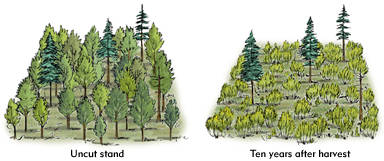
Note: Coppice systems were used in Europe by the Romans and during the Middle Ages mostly to provide firewood for fuel.
Patch cut system
The patch cut system involves removal of an entire stand of trees less than one hectare in size from an area. Each patch cut is managed as a distinct even-aged opening. If an area contains several patch cuts, each opening is still managed as a distinct opening. Regeneration is obtained either by artificial or natural regeneration, or a combination of the two.
As mentioned earlier, this system is a clearcut variant. However, in BC we wish to recognize that these very small openings have characteristics that differ from a typical clearcut.
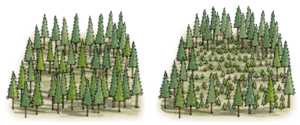
A patch of the stand is generally cleared, removing the forest overstorey in one harvest at the end of the rotation. The regeneration period occurs soon after the harvest and is short.
Other definitions of patch cuts
Smith (1986) recognized the patch cut system as a type of clearcut silvicultural system that promotes natural regeneration in small openings. All definitions of patch cuts include the concept of small openings that will be managed as individual stand units, unlike the openings created in a group selection or group shelterwood situation.
Retention silvicultural system
Retention system means a silvicultural system that retains individual trees or groups of trees to:
- maintain structural diversity over the area of the cutblock for at least one rotation
- leave more than half the total area of the cutblock within one tree height from the base of a tree or group of trees, whether or not the tree or group of trees is inside the cutblock.
Retention can be dispersed throughout a cutblock as single trees or aggregated groups of trees.
The proportion of an opening that is influenced by the surrounding trees differentiates a clearcut from a retention system. Kimmins (1992) defined clearcutting as the harvesting of all trees in a single cut from an area of forest large enough so that the 'forest influence' is removed from the majority of the harvested area.
In practice, seldom will any spot within a retention system opening be more than two tree heights away from standing trees. This will result in more than half of the opening being influenced by surrounding trees.
In the retention system, we think about what will be retained instead of what can be removed! Retention areas should be designed to provide late successional structures to enrich diversity, enhance habitat connectivity over the landscape, and supply refuges for survival and dispersal of species after harvesting.
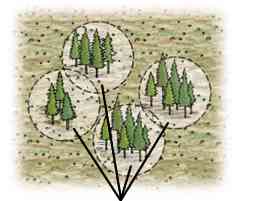
Area under forest influence. One tree height equals area of forest influence. Note: not drawn to scale.
Retention objectives are unique to the individual area or landscape unit. These objectives must be clearly expressed in the operational plan for the area.
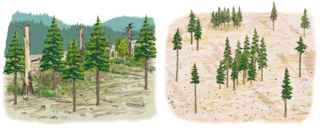
Retention structures can be dispersed, aggregated, or a combination of the two.
Case study
A very enthusiastic, but inexperienced young silviculturist is inspecting a five-year-old cutblock in the interior with an older forester. The young forester is fresh from an introductory course in silvicultural systems and is keen to use the terms he has learned. On the cutblock the young forester observes Douglas-fir and lodgepole pine interspersed with rapidly sprouting birch stumps. The birch sprouts cover approximately 50% of the block by area. No overstorey trees were left.
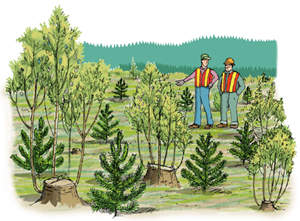
The young forester reads 'clearcut' under silvicultural system in the pre-harvest prescription. He turns to the older forester and says, "Technically, you know this is a coppice system with standards until the birch sprouts are eliminated through brushing, at which point I would call it a clearcut."
"Whoa, hold on there young fella!" the older forester exclaims. "I think you still have a lot to learn here."
Why do you think the older forester responded in this way?
For discussion, see appendix 1, "A Sprouting Concern"
Uneven-aged systems
Selection system
In the selection system, the only uneven-aged system, mature timber is removed either as single scattered individuals or in small groups at relatively short intervals, repeated indefinitely, where an uneven-aged stand is maintained. Regeneration should occur throughout the life of the stand with pulses following harvest entries.
This system depends on recruitment of trees into successive age classes over time and the predictable yield from merchantable age classes. Yield will be obtained by thinning clumps, harvesting individual trees, or by harvesting whole groups of the most mature age class to create small openings scattered throughout the stand.
The selection system can be very complex. Because three variants of selection systems are used and are treated quite differently in BC, these systems are detailed in Part 3.
What about selective logging?
People often confuse the term selective logging with selection system. The term selective logging is still used today by members of the public to describe any harvesting practice that does not clearcut, but rather leaves a significant number of leave-trees. Many foresters resist the use of this term as a synonym for the selection system, or any form of forest management.
In the past selective logging was used to remove the largest, highest quality trees from a stand. Selective logging amounted to mere exploitation, requiring little or no silvicultural skill. This style of cutting did not provide for regulated sustained yield and often resulted in overstocked stands with a deteriorated gene pool. From a long-term management perspective this approach to harvesting was similar to shooting the top three finishers in a horse race and putting the last place horses out to stud.
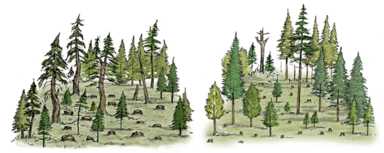
Selection system harvested stand / 10 years after harvest.
The term selective logging should not be used in silvicultural terminology due to its association with these crude practices. Where a term is sought for all systems that do not include clearcutting, partial cutting systems is more useful and accurate.
Note: As Swiss foresters tried to transfer German clearcut/even-aged approaches to Switzerland, they encountered problems due to differences in climate, terrain and land tenure. Karl Gayer and Arnold Engler encouraged a more "natural system" in the late 1800s. In 1920, Henri Boilley built on the work of French forester Adolph Gurnaud to develop the "check method," the precursor to the modern selection system.
Quote:
If selection fellings are to be raised to the status of a silvicultural system, something more is required than the mechanical removal of exploitable trees.
John Mathews (1989)
Self test questions
- What is the difference between clearcutting in terms of a silvicultural system and clearcutting as a style of logging?
- Describe all the differences between a seed tree system and a shelterwood system in both function and structure.
- Describe the four potential shelterwood harvesting entries and the goals for each entry.
- When does a seed tree system become a shelterwood system? What density of trees constitutes a seed tree as opposed to a shelterwood? Explain why these are difficult questions to answer.
- A successful selection system depends on two principles of uneven-aged management. What are they?
- What is selective logging and what is its relationship to the selection system?
- Explain the coppice system and suggest how it may be applied in BC.
- Define patch cut and explain why it is presented separately from the clearcut system.
- Why might we use the seed tree with reserves system? Can other systems also be used with reserves?

